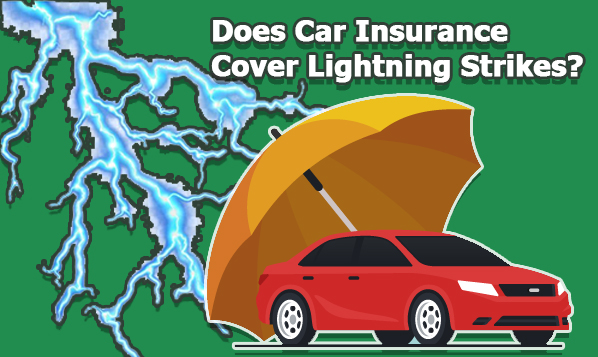Most drivers get protection because of their automobile’s rubber tires, which prevent them from lightning damage while you’re inside. However, lightning strikes directly or indirectly, causing damage to your car if it falls on a nearby object. Since car insurance protects you from unanticipated harm, you might wonder if it can cover lightning strikes.

Yes, if you have comprehensive coverage, your car insurance can cover lightning strikes. Moreover, review your policy documentation to determine the losses your insurance company will cover during a lightning strike. This article discusses the coverage type required for lightning strikes, the process of submitting a claim, and other relevant details.
What Type of Car Insurance Cover Lightning Strikes
To make sure you get coverage, your policy must provide comprehensive coverage. You won’t get coverage for lightning strikes if you only have liability and collision coverage. Comprehensive insurance offers coverage against extreme weather events, such as lightning strikes, theft, vandalism, and lightning damage. If your house gets hit by lightning without it, you will be responsible for the cost of repairs. Insurance providers will issue a cash value check upon acceptance of a claim and repair payment for a car declared a total loss due to irreparable damage.
When Does Car Insurance Cover Lightning Strikes
If comprehensive insurance is purchased before a lightning strike, it will cover damage from such hits. It includes replacements or repairs for damage not caused by collisions, like fallen tree branches, animals, or lightning. In addition to collision coverage, most drivers also have comprehensive insurance.
Although full-coverage insurance is not mandatory by law in any state, it may be necessary by lenders or leasing companies. Also, any damage caused by lightning would be your responsibility if you didn’t have comprehensive insurance, and repairs may run into the hundreds or thousands of dollars. Therefore, having adequate insurance is crucial.
When Does Car Insurance Not Cover Lightning Strikes
You won’t get coverage against a lightning strike if your car insurance policy doesn’t have comprehensive coverage. Liability insurance and other state-mandated requirements only cover damage to other drivers, not your car. Also, loan leasing companies usually need full coverage to protect their investment in the vehicle, even though no state requires comprehensive auto insurance for lightning strike damage. Even if you have more liability insurance than your state requires, you will still be liable for lightning strike damage if you do not have physical damage coverage.
What Happens When Lightning Strikes a Car
Generally, lightning strikes a car through its metal frame and into the ground, protecting the people inside. However, significant damage, mostly electrical, may be done to the vehicle itself. It might melt components of the car’s frame, harm the radio and navigation system, destroy the battery, or fry the electrical system.
What to Do When Driving Through Lightning
There are several safety measures you may take to help protect yourself and prevent expensive damage to your car if you are traveling during a lightning storm.
- Move to away to the roadside.
- Activate your hazard or emergency lights.
- Switch off your vehicle.
- Keep your windows and doors secure.
- Hold off till the storm passes.
Moreover, you should not remain outside if your car is struck by lightning. Also, it’s advisable to exit your vehicle and locate an indoor location for coverage, such as a restaurant or store.
How to Know If Your Vehicle Was Hit By Lightning
There are several indicators that a lightning strike has occurred. Burn scars or melted components may be seen, especially around the antenna and other metallic regions. Also, your vehicle may not start or your electrical systems may not function properly. The extreme heat of the lightning may occasionally cause tires to burst or puncture.
How to Fix a Car Struck By Lightning
If your car is hit by lightning, it’s crucial to submit a claim promptly, provided you have comprehensive insurance. While electrical issues are more difficult to accurately link to a lightning strike, physical damage caused by lightning is an obvious sign of the incident. If lightning damage was not present at the time, have your car inspected by a mechanic as soon as possible.
To prove that the mechanic’s reported issues were caused by a thunderstorm, consider gathering information or storm reports. Furthermore, it might be simpler to have your claim accepted with this additional information.
How to File a Claim for Lightning Strikes
Filing a claim after a lightning strike is a similar procedure to that of other insurance filing claims. You must take the same actions as other comprehensive claims to submit a claim following a lightning strike. The following procedures include:
- Consult an insurance provider: After encountering a lightning strike, you must tell your insurance provider about it.
- Share information about the event: Record and take pictures of the car, and share information about the impact, such as where you were, how much damage was done to the vehicle, and any other details you may have.
- Inquire about your coverage: Verify your eligibility before filing a claim by inquiring with your insurance company about the deductible for your policy and whether you are currently covered for lightning strikes.
- File a claim: If lightning causes significant damage to your car and it doesn’t require major repairs, you can pay for it out of pocket.
- Observe your claim progress: Maintain communication with external parties like repair shops and provide timely information to the claims adjuster to ensure the success of your claim and increase its chances of success.
Verify whether you or a repair company will receive the money from your insurer after your claim has been handled. Also, you can use the processes your organization has established for resolving claims disputes to appeal the verdict if you don’t agree with it.

